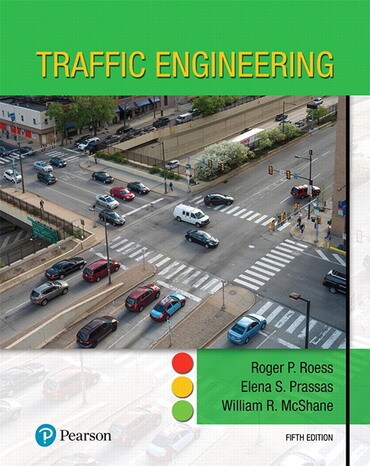
Traffic Engineering, 5th edition
- Roger P. Roess |
- Elena S. Prassas |
- William R. McShane |
Title overview
For courses in traffic engineering.
Focuses on the key skills and understanding required for careers in traffic engineering
Traffic Engineering presents both fundamental theory and a broad range of its applications to solve modern problems and gives students an understanding of and appreciation for planning, design, management, construction, operation, control and system optimization. An emphasis on modern data collection tools and methodologies provides students with the details of how modern technology is used in the collection, reduction and analysis of data.
The 5th Edition includes the latest in industry standards and criteria, new material and updates to existing material, as well as new homework problems.
Hallmark features of this title
- A critical blend of theory and methodology shows students the direct application of traffic engineering concepts to real-world situations.
- An emphasis on modern data collection tools and methodologies provides students with the details of how modern technology is used in the collection, reduction and analysis of data.
- The text is organized into four major functional parts and presented in an accessible format, giving students a clear and logical framework to learn the concepts.
- Numerous sample problems and illustrations demonstrate the procedures and methodologies as they are used in practice.
- Important computer programs demonstrate solutions throughout the text.
New and updated features of this title
- NEW: More than half of the homework problems for most chapters are new to this edition.
- NEW: Links to several new websites are included, which students and instructors will find valuable.
- NEW: Supporting material on statistical analyses, within the applications in which they are used, is included to supplement students' separate coursework in statistics.
- NEW: This edition includes new material on unsignalized intersections, roundabouts, alternative intersections, interchanges, operation and analysis of facilities, and more.
- UPDATED: Updated and extended material on signalized intersections, signal design and timing, and signal hardware is included.
- UPDATED: The 5th Edition includes the latest standards and criteria of the Manual on Uniform Traffic Control Devices (2009, as updated through May 2012), the Policy on Geometric Design of Highways and Streets (2011), the Highway Safety Manual (2010, with 2014 Supplement) and other critical documents.
Table of contents
I. Basic Concepts and Characteristics
- Introduction
- Transportation Modes and Characteristics
- Road-User, Vehicle, and Roadway Characteristics
- Communicating with Drivers: Traffic Control Devices
- Traffic Stream Characteristics
- The Concepts of Demand, Volume, and Capacity
- Level of Service and the Highway Capacity Manual: History and Fundamental Concepts
- Intelligent Transportation Systems
II. Traffic Studies and Programs
- Traffic Data Collection and Reduction Methodologies
- Traffic Volume Studies and Characteristics
- Speed, Travel Time, and Delay Studies
- Highway Traffic Safety: An Overview
- Parking: Characteristics, Studies, Programs, and Design
- Traffic Impact Studies and Analyses
III. Interrupted Flow Facilities: Design, Control, and Level of Service
- The Hierarchy of Intersection Control
- Traffic Signal Hardware
- Fundamentals of Intersection Design and Layout
- Principles of Intersection Signalization
- Fundamentals of Signal Timing and Design: Pre-timed Signals
- Fundamentals of Signal Timing and Design: Actuated Signals
- Signal Coordination for Arterials and Networks
- Capacity and Level of Service Analysis: Signalized Intersections–The HCM Method
- Planning-Level Analysis of Signalized Intersections
- Urban Streets and Arterials: Complete Streets and Levels of Service
- Unsignalized Intersections and Roundabouts
- Interchanges and Alternative Intersections
IV. Uninterrupted Flow Facilities: Design, Control, and Level of Service
- An Overview of Geometric Design of Roadways
- Capacity and Level of Service Analysis: Basic Freeway and Multilane Highway Segments
- Capacity and Level of Service Analysis: Weaving Segments on Freeways and Multilane Highways
- Capacity and Level of Service Analysis: Merge and Diverge Segments on Freeways and Multilane Highways
- Operation and Analysis of Freeways and Highways
Author bios
About our authors
Dr. Roger P. Roess is Department Head in the Department of Civil Engineering at Polytechnic Institute of NYU.
Elena S. Prassas is an Associate Professor in the Department of Civil Engineering at Polytechnic Institute of NYU. She earned her Doctor of Philosophy and Master of Science from Polytechnic University and her Bachelor of Arts from the State University of New York, Oneonta. She is a Member of TRB's Highway Capacity and Quality of Service Committee (HCQSC), the Chair of the HCQSC Signalized Intersection Subcommittee and a Member of both the ITE and WTS.
William R. McShane is the Vice President of Operations and Dean of Engineering at Polytechnic University. He earned his BSEE from Manhattan College and his MS and PhD in Systems Engineering from Polytechnic University. His areas of interest include quality control, controls and simulation and engineering economics.